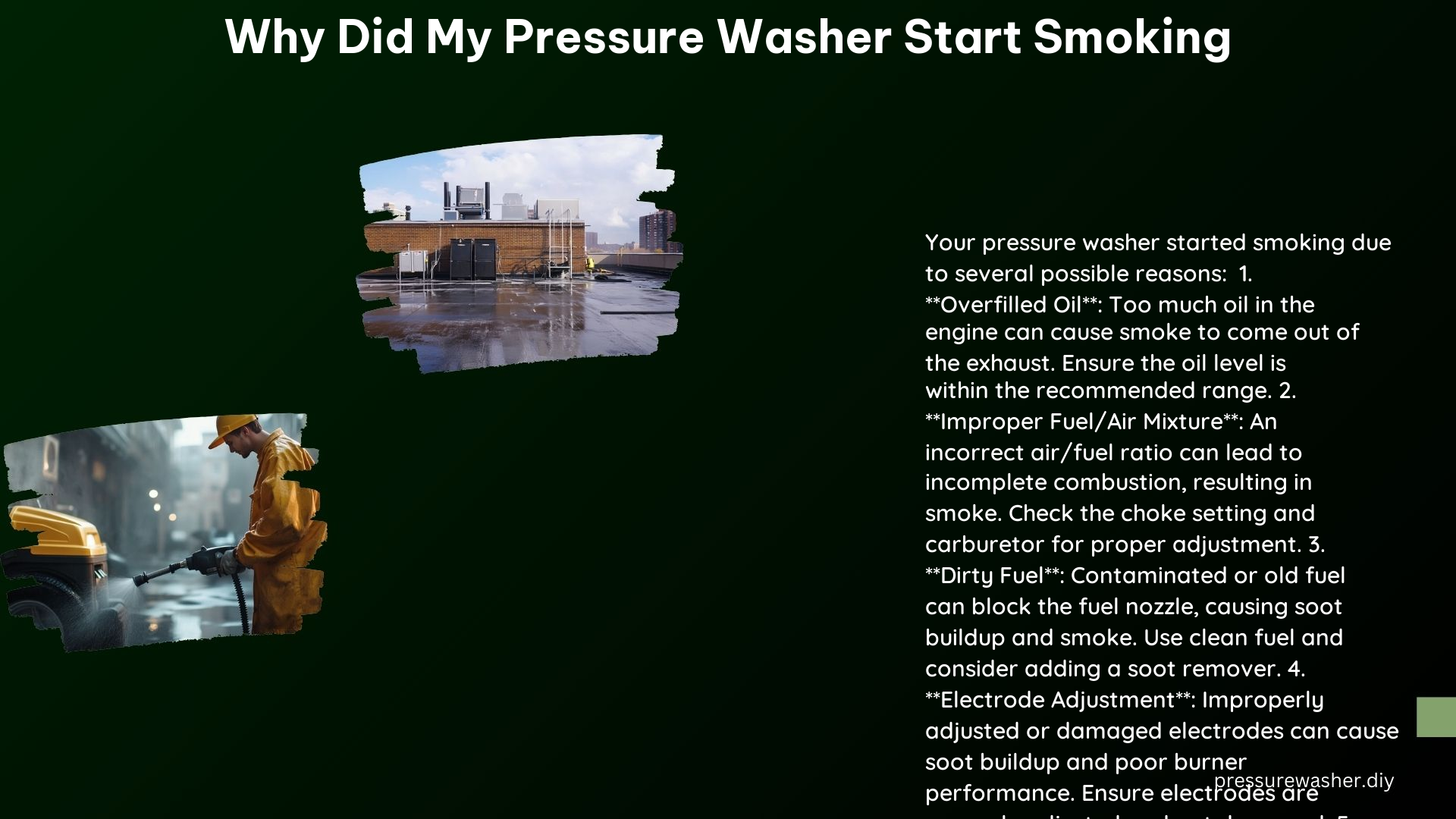If your pressure washer has started smoking, it can be a concerning issue that requires immediate attention. Smoke coming from a pressure washer can indicate a variety of underlying problems, ranging from improper fuel-air mixture to electrical issues. In this comprehensive guide, we’ll delve into the common causes of pressure washer smoke and provide you with detailed troubleshooting steps to help you identify and resolve the problem.
Common Causes of Smoke from a Pressure Washer
1. Overfilled Oil
One of the most common reasons for a pressure washer to start smoking is an overfilled oil reservoir. When the engine oil level is too high, it can lead to incomplete combustion, resulting in smoke being expelled through the exhaust. To address this issue, you’ll need to check the oil level using the dipstick and drain any excess oil until it reaches the recommended level.
Technical Specifications:
– Recommended oil level: Refer to the manufacturer’s specifications, typically between the “Full” and “Add” marks on the dipstick.
– Oil capacity: Varies by model, but typically ranges from 15 to 30 ounces (0.44 to 0.89 liters).
– Oil type: Use the oil type recommended by the manufacturer, usually SAE 30, 10W-30, or 10W-40 for small engines.
2. Improper Fuel/Air Mix
An incorrect air-to-fuel ratio can also cause smoke to come out of the pressure washer’s exhaust. This can happen if the choke is set incorrectly or the carburetor is not functioning properly. Ensure the choke is set to the appropriate position (usually fully open or partially closed) and clean or rebuild the carburetor if it’s clogged or dirty.
Technical Specifications:
– Choke position: Refer to the manufacturer’s recommendations, typically starting in the “Choke” position and gradually moving to the “Run” position as the engine warms up.
– Carburetor adjustment: Consult the service manual for the proper carburetor adjustment procedures, including the air-fuel mixture screw and idle speed adjustment.
– Carburetor cleaning: Use a carburetor cleaner and compressed air to thoroughly clean the carburetor components, including the jets, passages, and diaphragm.
3. Dirty Carburetor
A clogged or dirty carburetor can also lead to incomplete combustion and smoke. Over time, the carburetor can become blocked with dirt, debris, and varnish buildup, preventing the proper fuel-air mixture from reaching the engine. In this case, you’ll need to clean or rebuild the carburetor to restore proper operation.
Technical Specifications:
– Carburetor cleaning process: Refer to the manufacturer’s instructions or a small engine repair manual for the proper steps to disassemble, clean, and reassemble the carburetor.
– Carburetor rebuild kits: These kits typically include new gaskets, diaphragms, and other wear-prone components to restore the carburetor to like-new condition.
– Carburetor cleaning tools: You’ll need a carburetor cleaner, compressed air, and various small tools to disassemble and reassemble the carburetor.
4. Improper Electrode Adjustment
Maladjusted or damaged electrodes in the pressure washer’s burner can also cause soot buildup and poor combustion, leading to smoke. Ensure the electrodes are properly adjusted according to the manufacturer’s specifications and replace them if they are damaged or worn.
Technical Specifications:
– Electrode gap: Typically between 1/8 to 3/16 inch (3.2 to 4.8 mm), but refer to the manufacturer’s recommendations.
– Electrode condition: Inspect the electrodes for signs of wear, damage, or corrosion, and replace them if necessary.
– Electrode adjustment tools: You’ll need a spark plug gap tool or feeler gauge to measure and adjust the electrode gap.
5. Burning Dirty Fuel
Using old, contaminated, or dirty fuel can also lead to soot buildup and smoke. Over time, fuel can degrade, and impurities can clog the fuel nozzle, preventing proper combustion. To address this issue, use clean, high-quality fuel and consider adding a soot remover to your diesel fuel.
Technical Specifications:
– Fuel type: Use the fuel type recommended by the manufacturer, typically unleaded gasoline or diesel fuel.
– Fuel quality: Ensure the fuel is fresh, free of contaminants, and meets the appropriate octane or cetane rating.
– Soot remover: Look for a fuel additive specifically designed to remove soot and improve combustion in diesel engines.
6. Incorrect Voltage
Low voltage can also affect the burner performance, leading to soot buildup and smoke. Ensure the voltage supplied to the pressure washer is within the recommended range, typically between 110-120V for household models.
Technical Specifications:
– Voltage range: Refer to the manufacturer’s specifications, usually between 110-120V for household pressure washers.
– Voltage testing: Use a multimeter to measure the voltage at the power source and the pressure washer’s electrical connections.
– Voltage issues: If the voltage is outside the recommended range, you may need to address electrical problems in the power supply or the pressure washer’s wiring.
Troubleshooting Steps

- Check Oil Level: Ensure the oil level is within the recommended range to prevent overfilling.
- Adjust Choke and Fuel/Air Mix: Ensure the choke is set correctly and the carburetor is clean and functioning properly.
- Clean or Rebuild Carburetor: Clean or rebuild the carburetor if it’s clogged or dirty.
- Check Electrodes: Ensure electrodes are properly adjusted and not damaged.
- Use Clean Fuel: Use clean, high-quality fuel and consider adding a soot remover to your diesel fuel.
- Check Voltage: Ensure the voltage is within the recommended range.
Additional Tips
- Regular maintenance, including tune-ups and cleaning the carburetor, can help prevent soot buildup and smoke.
- If you’re unsure about how to troubleshoot or fix the issue, consider consulting a professional technician.
References
- Hotsy of Memphis. (n.d.). Is Your Pressure Washer Smoking? Retrieved from https://hotsyofmemphis.com/is-your-pressure-washer-smoking/
- Reddit. (2022, June 21). Why did my brand new pressure washer started to let out smoke for the exhaust? Retrieved from https://www.reddit.com/r/pressurewashing/comments/vh5jez/why_did_my_brand_new_pressure_washer_started_to/
- Sears PartsDirect. (2023, April 19). Why is smoke coming from the pressure washer’s exhaust? Retrieved from https://www.searspartsdirect.com/diy/symptom/gas-pressure-washer-repair/1235930/smoke-coming-out-of-the-engine-exhaust/pw10008
- YouTube. (2024, February 21). Smoking pressure washer engine. Retrieved from https://www.youtube.com/watch?v=Wp5YvqU7Lb0
- JustAnswer. (2024, May 22). My brand new power washer has smoke coming from the engine. Retrieved from https://www.justanswer.com/small-engine/p23sf-brand-new-power-washer-smoke-coming-engine.html
